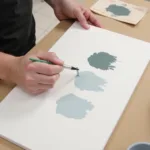The quest for the darkest color has captivated artists, scientists, and designers for centuries. What Is The Darkest Color In The World? The answer isn’t as simple as black. While black might seem like the obvious choice, recent advancements in material science have pushed the boundaries of darkness beyond what traditional pigments can achieve.
Imagine a color so dark it absorbs almost all light, rendering three-dimensional objects into flat, two-dimensional shapes. This isn’t science fiction, but the reality of Vantablack, a revolutionary material developed by Surrey NanoSystems. Initially, this material held the title of the darkest substance known to man, absorbing an astounding 99.965% of visible light.
This “super black” coating isn’t a pigment or a paint, but a specialized structure made from vertically aligned carbon nanotubes, millions of times thinner than a human hair. These microscopic tubes trap light, preventing it from escaping and creating an illusion of utter darkness. Have you ever wondered what color is shadow? It’s a complex question, influenced by factors like light sources and surrounding colors, a topic often explored in artistic endeavors.
However, the quest for ultimate darkness didn’t end there. MIT researchers later developed an even darker material, surpassing Vantablack in light absorption. This unnamed material, grown on vertically aligned carbon nanotubes similar to Vantablack, absorbs 99.995% of incoming light. This pushes the boundaries of what we perceive as black.
Delving into the Darkness: Beyond Vantablack
The creation of these super black materials has implications beyond mere novelty. Their unique properties have sparked interest in various fields, from aerospace engineering to art. Vantablack, for example, can be used to calibrate telescopes, reduce glare in optical systems, and even create stunning works of art.
The discovery of these incredibly dark materials raises fascinating questions about our perception of color and the nature of light itself. What does it mean for a color to be truly black? How does our brain interpret the absence of light? These are just some of the questions scientists and artists continue to explore. Knowing what is a base color for hair can be as complex as understanding the nuances of Vantablack, since both involve the interplay of pigments and light.
Why is Vantablack So Dark?
The secret to Vantablack’s darkness lies in its unique structure. The densely packed carbon nanotubes create a forest of microscopic light traps. When light enters this forest, it bounces between the tubes, losing energy with each bounce until it’s eventually absorbed as heat. Very little light is reflected back, making the material appear incredibly dark. Learning how do you color modeling chocolate, on the other hand, involves adding pigments to a base material, a different approach than the light absorption of Vantablack.
How is Vantablack Used?
Vantablack’s extraordinary properties have found applications in various industries. In aerospace, it’s used to coat components of telescopes and other optical instruments, minimizing stray light and improving sensitivity. In art, artists like Anish Kapoor have explored its potential, creating sculptures that seem to defy depth and dimension. Just like understanding what color eggs can chickens lay is based on pigments and genetics, understanding the color of Vantablack comes down to material science and nanotechnology.
“The experience of Vantablack is quite disorienting,” says Dr. Anya Sharma, a materials scientist specializing in nanomaterials. “It’s like looking into a void, a place where light seems to cease to exist.”
The Future of Dark Colors
The development of Vantablack and subsequent even darker materials has opened up exciting possibilities in material science and beyond. Researchers are continuing to explore new ways to manipulate light and create even more extreme colors. These advancements could lead to new technologies and applications we can only imagine today. For instance, hair braiding and coloring have evolved to include an extensive range of colors. To find the perfect shade, you can explore what color is 30 in braiding hair to see if it fits your style.
“The pursuit of the darkest color is not just a scientific curiosity,” explains Dr. David Chen, a physicist working on light-absorbing materials. “It’s a journey into the fundamental nature of light and how we interact with it.”
Conclusion
While traditionally, black was considered the darkest color, advancements in material science have redefined our understanding of darkness. Vantablack and similar materials, with their exceptional light-absorbing properties, represent a new frontier in the world of color. These materials, initially developed for scientific purposes, have found their way into art, aerospace, and other fields, demonstrating the potential of pushing the boundaries of what’s possible. The search for the darkest color continues, prompting us to rethink what we know about light, color, and the very nature of perception.
FAQ
- What is Vantablack made of? Vantablack is made of vertically aligned carbon nanotubes.
- What is the darkest color in the world? Currently, a material developed at MIT is considered the darkest, surpassing even Vantablack.
- What are the applications of Vantablack? Vantablack is used in aerospace, art, and other fields for its light-absorbing properties.
- Why is Vantablack so dark? Its structure of carbon nanotubes traps light, preventing it from reflecting back.
- Can I buy Vantablack paint? Not in the original form, but there are commercially available alternatives inspired by it.
- What is darker than Vantablack? The material developed by MIT absorbs even more light than Vantablack.
- How does Vantablack impact art? It creates a unique visual effect, allowing artists to explore new dimensions of darkness and depth.
Contact Us
For assistance, contact us at Phone: 0373298888, Email: [email protected] Or visit our address: 86 Cau Giay, Hanoi. We have a 24/7 customer service team.

